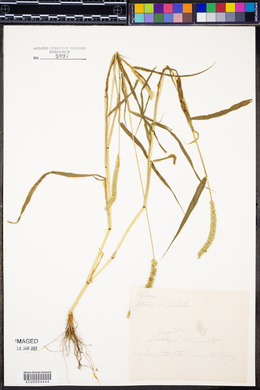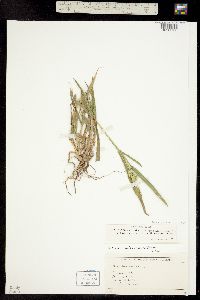Setaria verticillata
|
|
|
|
Family: Poaceae
hooked bristlegrass, more...Rough Bristle Grass, bristly foxtail, bur bristlegrass, Sétaire Verticillée
[Chaetochloa verticillata (L.) Scribn., moreChaetochloa verticillata var. breviseta (Mutel) Farw., Chamaeraphis italica var. verticillata (L.) Kuntze, Chamaeraphis verticillata (L.) Porter, Ixophorus verticillatus (L.) Nash, Panicum respiciens (Hochst. ex A. Rich.) Hochst. ex Steud., Panicum rottleri (Spreng.) Nees, Panicum verticillatum L., Panicum verticillatum var. brevisetum Mutel, Pennisetum verticillatum (L.) R. Br., Setaria adhaerens subsp. verticillata (L.) Belo-Corr., Setaria adhaerens var. vertillata (L.) Belo-Corr., Setaria carnei A.S. Hitchc., Setaria leiantha f. subhirsuta Hack., Setaria numica Link, Setaria pratensis Phil., Setaria respiciens (Hochst. ex A. Rich.) Walp., Setaria rottleri Spreng., Setaria verticillata var. verticillata , Setaria viridis var. insularis A. Terracc., Setariopsis verticillata (L.) Samp.] |
Plants annual. Culms 30-100 cm; nodes glabrous. Sheaths glabrous, margins ciliate distally; ligules to 1 mm, densely ciliate; blades 5-15 mm wide, flat, abaxial surfaces scabrous. Panicles 5-15 cm, tapering to the apices; rachises retrorsely rough hispid; bristles solitary, 4-7 mm, retrorsely scabrous. Spikelets 2-2.3 mm. Lower glumes about 1/3 as long as the spikelets, obtuse, 1(3)-veined; upper glumes nearly as long as the spikelets; lower paleas about 1/2 as long as the spikelets, broad; upper lemmas finely and transversely rugose; upper paleas similar to the upper lemmas. 2n = 18, 36, 54, 72, 108. Setaria verticillata is a European adventive that is now common throughout the cooler regions of the contiguous United States and in southern Canada. It is an aggressive weed in the vineyards of central California. Reports of S. carnei Hitchc. from North America are based on misidentification of this species. Setaria verticillata resembles S. adhaerans, but differs in having longer panicles and spikelets, sheath margins that are ciliate distally, and blades that are scabrous, not hairy. Setaria verticillata is a more northern species than S. adhaerans, but their ranges overlap in the Flora region. Annual herb, tufted 30 cm - 1 m tall Leaves: alternate, two-ranked. Sheaths fringed with hairs near the apex. Ligules to 1 mm long, membranous, with a dense fringe of hairs marginally. Blades 0.5 - 1.5 cm wide, lance-shaped, flat, rough beneath, parallel-veined. Inflorescence: a terminal arrangement of spikelets (panicle), dense, 5 - 15 cm long, spike-like, tapering to the apex, with numerous rough bristles 4 - 7 mm long. Axis roughly hairy. Fruit: a caryopsis, indehiscent, enclosed within the persistent lemma and palea, ellipsoid to nearly spherical. Culm: upright or decumbent, 30 cm - 1 m long, round in cross-section. Spikelets: nearly stalkless to short-stalked, about 2 mm long, lance-shaped to ellipsoid. Glumes:: Lower glumes about one-third as long as spikelets, blunt at the apex, usually one-veined, membranous. Upper glumes almost as long as spikelets. Lemmas:: Lower lemmas equal to upper lemmas, five- to seven-veined, membranous. Upper lemmas hardened, finely wrinkled. Paleas:: Lower paleas about half as long as spikelets, wide. Upper paleas similar to upper lemmas, hardened, wrinkled. Florets:: Lower florets sterile or male. Upper florets bisexual. Anthers three. Styles two. Stigmas red. Similar species: No information at this time. Flowering: July to mid-October Habitat and ecology: Introduced from Europe and now frequent in cornfields and other cultivated areas. It is also found in waste ground as a weed. In the industrial areas of cities it may be found growing between the buildings and in the cracks of sidewalks. Occurence in the Chicago region: non-native Etymology: Setaria comes from the Latin words seta, meaning bristle, and aria, meaning possessing. Verticillata means whorled. Author: The Morton Arboretum Common Name: hooked bristlegrass Duration: Annual Nativity: Non-Native Lifeform: Graminoid Synonyms: Chaetochloa verticillata, Panicum verticillatum, Setaria carnei Annual 3-10 dm, scabrous just beneath the infl; sheaths ciliate- margined above; blades flat, 10-25 cm נ5-15 mm, scabrous on both sides, sometimes also with scattered hairs above; infl erect, yellow-green or purplish, 5-15 cm, cylindric but lobulate, the branches verticillate, the axis scabrous-hispid on the angles, not villous; bristle one below each spikelet, 4-7 mm; spikelets 2-2.2 mm; first glume 1(-3)-veined, a third as long as the spikelet, the second 5-veined, nearly as long as the spikelet; sterile lemma nearly as long as the spikelet, clasping a rather broad palea half as long; fertile lemma transversely finely rugulose; 2n=36. Native of the Old World, now widespread in N. Amer. as a weed in gardens and greenhouses, and along the banks of streams and irrigation-ditches. Var. verticillata has the bristles retrorsely scabrous, and the axis of the panicle is retrorsely scabrous-hispid. The much less common var. ambigua (Guss.) Parl. has the bristles and panicle-axis antrorsely instead of retrorsely scabrous. (S. viridis var. ambigua) Gleason, Henry A. & Cronquist, Arthur J. 1991. Manual of vascular plants of northeastern United States and adjacent Canada. lxxv + 910 pp. ©The New York Botanical Garden. All rights reserved. Used by permission. From Flora of Indiana (1940) by Charles C. Deam This species has been reported from 7 counties. It is found sparingly (in waste places) probably throughout the state. I have known it in Wells County for 10 years. I first found it in a vacant lot in Bluffton and 10 years later I found it along the roadside outside of the city. Doubtless wherever it gets a start it will gradually spread. …… Indiana Coefficient of Conservatism: C = null, non-native Wetland Indicator Status: FAC |




























































































